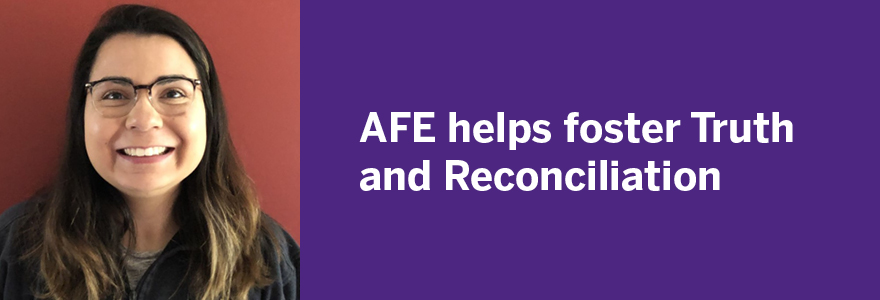
Leeanne Doxtator

Leeanne Doxtator
Understanding and recognizing Treaties are important for Truth and Reconciliation to occur with Indigenous Peoples. That's the lesson one teacher candidate learned during her Alternative Field Experience (AFE).
Leeanne Doxtator completed her AFE at the Ska-Nah-Doht Village and Museum in Mount Brydges, Ontario. As someone who identifies as Indigenous, working at the museum helped her learn about her culture and history, including the culture and history of other First Nations.
"Not only was I able to learn more about my own Nation, Oneida of the Thames, but also the surrounding Nations, such as Chippewa of the Thames and the Muncee-Delaware Nation," said Doxtator.
During her four-week placement, Doxtator focused her research on Wampum Belts and Treaties that affected local First Nations communities from pre-colonization to the present day. Her findings will be used in educational programming and staff development.
Doxtator will also develop a museum display about Truth and Reconciliation towards Indigenous Peoples. It will feature Wampum Belts and artifacts as well as a timeline for Treaties and belts.
"Due to current circumstances we could not offer a teaching experience for Leeanne and I hoped that researching local Treaties and Wampum Belts would provide an experience both professionally as she embarks on this career path in teaching and personally as she connects with her Indigenous heritage," said Curator of the Ska-Nah-Doht Village and Museum, Karen Mattila.
Wampum Belts are made from Wampum beads, which are beads made from a clam shell called Quahog. They are used as visual memory keepers that record history and reminders of agreed laws and values, explained Doxtator.
As part of the display, Doxtator said the timeline will date back to the first evidence of human occupation of the northern half of North America and include crucial dates of Treaties and Wampum Belts created during that time. Some belts in the display will include "Dish with One Spoon," which was a treaty concerning shared hunting grounds. Also part of the display will be the "Two Row Wampum," which is one of the oldest treaty relationships between the Haudenosaunee and Dutch settlers.
"It's important for us to be leaders in Truth and Reconciliation and reflect First Nations voices in our presentations," said Mattila.
The Ska-Nah-Doht Village and Museum is part of the Lower Thames Conservation Authority and the Oneida of the Thames, Chippewa of the Thames and the Muncee-Delaware Nation are located on the Lower Thames watershed.
Mattila said the pandemic had a devastating effect on the museum because they closed their doors just before March Break and educational programming stopped.
"With the future unknown, we decided to focus on researching for a new program on Treaties," said Mattila. "This program was tested in 2019 on one Grade 5 and two Secondary First Nations, Metis and Inuit classes. We found it needed more research and this approach worked for this placement."
While Doxtator hasn't been able to display her exhibit, she will get it ready for public viewing when the museum reopens.
"It's something that I am looking forward to as I believe it will be a fun, informative and an interesting display for museum visitors and school groups," she said.
What's more, Doxtator learned to work virtually in a museum setting. She had phone meetings, communicated via email and conducted her research from home. Her experiences during this pandemic has also made her adaptable and self-reliant. For example, she created a schedule to ensure her assignments were completed in a timely manner.
"I have learned the importance of having a great support system of people who encourage you and motivate you to learn and grow not only as a person but also as a teacher."
The COVID-19 pandemic forced Doxtator to scramble for an alternative placement. Initially, she was going to an American Creativity Academy in Kuwait. However, her placement was cancelled one week before she was due to leave.
"Luckily, I worked as a summer student at Ska-Nah-Doht Village and Museum during the summer of 2016 and 2017," said Doxtator. "I always knew that Karen Mattila, my former supervisor, would be happy to have me back to complete this placement."
Going forward as a teacher, Doxtator hopes her AFE experience will help her teach students about local First Nations' history. It will also allow her to incorporate Indigenous teachings into everyday subjects and she will ensure her students become well-rounded individuals who know Canadian history.